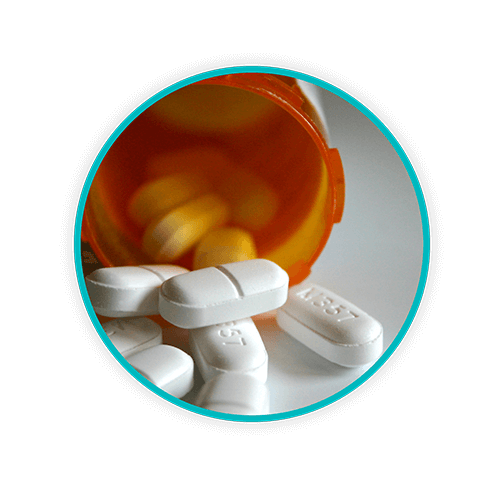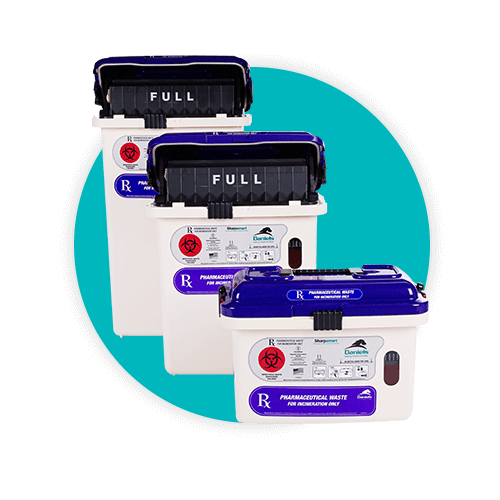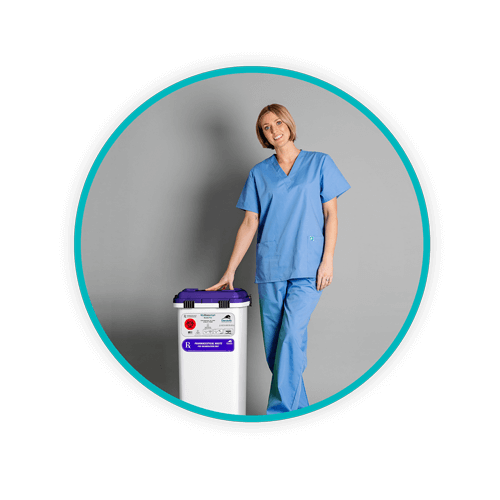Common Mistakes When Disposing of Pharmaceutical Waste

What are the most common mistakes made by healthcare professionals disposing of pharmaceutical waste? It’s a question every leader in any healthcare setting will want answers to. Current pharmaceutical waste management regulations have reduced pharmaceutical waste disposal problems for the healthcare sector in recent years. However, there are still many steps in the life cycle of pharmaceuticals where errors can occur.
By identifying the gaps in pharmaceutical handling, steps can be taken to avoid them from happening again in the future. And there’s plenty of good reasons to prevent these pitfalls, including minimizing risk of legal consequences and damaging lawsuits as well as the larger danger to the environment and public health.
First, it’s important for healthcare workers to understand pharmaceutical waste management regulations. But education alone may not often be enough. Taking steps to make it easier to remain compliant is a critical step to ensuring pharmaceutical waste is disposed of safely and securely.
TOPICS WE WILL COVER:
1 / What is pharmaceutical waste?
2 / What are the dangers of improper pharmaceutical disposal?
3 / Four common pharmaceutical waste mistakes
4 / What to look for in pharmaceutical waste storage containers
6 / Key takeaways on pharmaceutical waste mistakes
What is Pharmaceutical Waste?
Pharmaceutical waste contains unwanted, contaminated, damaged, or expired medications. This could include hazardous and non-hazardous prescription medications and leftover over-the-counter medications such as paracetamol. In either case, they pose a risk to people and the environment if disposed of improperly. Therefore, healthcare facilities develop pharma waste disposal plans and conduct drills to educate workers and employees. In general, they also keep pharmaceutical waste disposal containers in their facilities.
Here are a few pharma waste products that require proper disposal process:
What are the Dangers of Improper Pharmaceutical Disposal?
Pharmaceutical waste from unused or expired medications adds to environmental damage when disposed of improperly. Medications dumped into sinks and toilets enter the sewage system and can ultimately impact freshwater and marine habitats. Illegally discarded pharma waste accumulates and pollutes landfills. Also, pharmaceutical waste poses a chance for accidental or deliberate misuse and harm to the general public and wastes valuable healthcare resources.
Four Common Pharmaceutical Waste Mistakes
Since every organization is different, it’s important to run a waste disposal audit of your specific healthcare setting to identify the mistakes unique to your organization. Pharmaceutical mistakes can cause multiple negative side effects:
- Financial damages
- Legal implications
- Physical harm to staff, patients or visitors
- Wasted budgets
Below are some of the most common mistakes when it comes to handling and disposing of pharmaceutical waste.
1. Not Classifying Waste Properly
It’s important to present clear guidelines so staff easily and quickly can identify which type of pharmaceutical waste they are disposing of. Providing a plan of action, such as a chain of command where inquiries can quickly be addressed can prevent improper disposal. In addition, clear labels on every waste receptacle can help to erase some of the confusion.
Many times overclassification is the cause of excess waste disposal costs for a healthcare setting. Although only around 5% of pharmaceutical waste is categorized as hazardous, it can be a challenge to determine which drugs fall into this realm. Of course, erring on the side of caution is better than disposing of hazardous drugs in general receptacles. However, overclassification can put a strain on hospital resources and cause unnecessary waste expenses.
2. Overfilling Containers
When containers like sharps containers get overfilled, they can become sources of misuse. Sharps often contain residual pharmaceutical waste, which needs to be properly disposed of. By using a secure sharps container, like Sharpsmart, engineered with a tamper-proof, stacking design, non-hazardous pharmaceutical waste can be safely disposed of in an efficient and safe manner. When containers are full, the collection tray is designed to “lock” into place to avoid overfilling.
3. Still Using Unsecure Containers
Pharmaceutical waste has health and safety implications beyond standard regulated medical waste. It can house medications or substances which can be abused or stolen. This can lead to legal and financial ramifications for a hospital, pharmacy or healthcare facility, not to mention the safety and health concerns from possible tampering. Daniels Pharmasmart is designed to address the gaps in securing pharmaceutical waste. This includes tamper-proof locks, brackets for securing containers to walls and restricting access to prevent the removal of pharmaceutical waste. Pharmasmart containers also are designed to be one seamless piece, helping to prevent disassembly or detachment of its components. For more on how to specifically handle controlled substances, which require additional destruction steps, start here.
4. Lack of Inspections
Routine audits and analysis of the pharmaceutical waste solution is a critical step to identifying and solving issues before they become damaging. Daniels has helped many hospitals and healthcare environments assess their current pharmaceutical waste practices to analyze what steps need to be implemented to improve conditions and address common mistakes like those listed above. Mistakes are common, particularly when it comes to pharmaceutical waste. But by defining what mistakes are occurring, solutions can be found.

What to Look for in Pharmaceutical Waste Storage Containers
The health of the environment, your staff’s welfare, and your organization’s success depend on using the best safety procedures while managing pharmaceutical waste. The key to effective waste management is choosing suitable pharma waste storage containers and using them properly.
But this can be an overwhelming process, especially for time-crunched, budget-conscious management teams. Daniels helps leadership teams to create procedures and guidelines to manage waste according to federal regulations and their specific needs. This includes helping you choose the right container for proper disposal and providing guidelines for effectively implementing a streamlined, fool-proof process.
How is Daniels Different?
Daniels Health is a leading waste removal and management company in the United States. Creating intelligent waste disposal infrastructure for hospitals, pharmacies and other healthcare settings, Daniels provides pharmaceutical waste solutions that address these common disposal mistakes. By combining intuitive container design with an environmentally-friendly reusable solution, Daniels is ushering in a new era of practical waste management.
Key Takeaways on Pharmaceutical Waste Mistakes
No matter how much or how little pharmaceutical waste you produce, an effective waste management system is essential. With such a system, you can ensure proper storage and disposal of unused, out-of-date, or other pharmaceutical waste from medical facilities according to regulations by healthcare regulating bodies. As a result, you can protect people and the environment.
Daniels can help you assess and improve your current system, guiding you through every step from education to implementation. Want to learn more about managing harmful pharmaceutical disposal systems? Schedule a consultation and talk with our experts now.
Let's Talk!
Your time is valuable, and we don’t want to play hard to get. You can either phone us directly on the details listed on our contact page, or feel free to fill out this short form and one of our team members will get back to you as quickly as possible.
